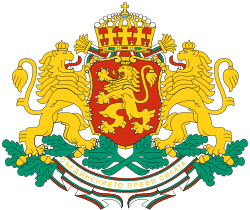Bulgarian Australians
| Total population | |
|---|---|
|
(2,680[1] (by place of birth) 4,870[1] (by ancestry)) | |
| Regions with significant populations | |
| New South Wales, Victoria, Queensland, South Australia | |
| Languages | |
| Australian English, Bulgarian | |
| Religion | |
| Bulgarian Orthodox Church | |
| Related ethnic groups | |
| Macedonian Australians |
| Part of a series on |
| Bulgarians българи |
|---|
 |
| Culture |
|
| By country |
| Subgroups |
| Religion |
| Language |
| Other |
|
Bulgarian Australians (Bulgarian: австралийски българи, avstraliyski balgari) refers to Australian citizens of Bulgarian ancestry. According to the 2006 Australian census, 2,680 residents of Australia were born in Bulgaria. Of these, 850 lived in New South Wales, 840 in Victoria, 340 in Queensland and 340 in South Australia. Some 4,870 people claimed full or partial Bulgarian ancestry.[1] Some unofficial estimates claim that the number of Bulgarians in Australia is around 20,000;[2] others, who count the Bulgarian Australian and the later Macedonian Australian diaspora together for historical reasons,[3] estimate a total number of around 100,000.[4]
History
The first traces of Bulgarian emigration to Australia date back to 1876, when an unknown number of Bulgarians fleeing the Ottoman atrocities in the wake of the April Uprising settled in Queensland and Tasmania. According to 1891 statistics, only 14 Bulgarians lived in Australia.[5] Following the anti-Ottoman Ilinden–Preobrazhenie Uprising of 1908, around 100 Bulgarians from Macedonia and southern Thrace emigrated to Australia.[6] The first more prominent Bulgarian colony was formed in Perth, Western Australia, in 1906–07.[7]
The first larger organized group of Bulgarian emigrants arrived in Australia in 1907 and consisted of around 100 people, most from the Veliko Tarnovo region; 30 of these disembarked in Adelaide, South Australia, 35 in Melbourne, Victoria and 35 in Sydney, New South Wales.[5] In 1912, Bulgarian gardeners bought out the swampy lands of Fulham near Adelaide and turned these into fruit gardens. The Bulgarian colony in Adelaide was among the fastest-growing Bulgarian colonies in Australia; many settlers from the villages near Veliko Tarnovo arrived in the 1920s to work in the city as gardeners. The Bulgarian community in Melbourne was established in 1910–1911.[8]
After the end of World War II, there was an influx of hundreds of Bulgarian political emigrants who did not accept the newly established communist authority in Bulgaria. It is difficult to establish the exact number of Bulgarian settlers in the pre-World War II period, but one estimate puts the number of emigrants from the Kingdom of Bulgaria at 1,000, with another 5,000 to 6,000 ethnic Bulgarian emigrants from Macedonia, Dobruja and Bessarabia.[9]
It was not until 1950 that Bulgarian Orthodox church communities were officially established.[10] The Bulgarian Orthodox churches in Australia are part of the Bulgarian Eastern Orthodox Diocese of the USA, Canada and Australia. Today, there are three Bulgarian Orthodox churches in Australia: the Saint John of Rila Bulgarian Eastern Orthodox Church in Macquarie Fields, Sydney, the Saint Petka Bulgarian Eastern Orthodox Church in Adelaide, and the Saints Cyril & Methody Bulgarian Eastern Orthodox Cathedral in Melbourne.[11]
Notable people
- Iwan Iwanoff (1919–1986), architect
- Anelia Pavlova (Annael) (b. 1956), artist
- Nik Radev (1959–2003), criminal
- Martin Marinov (b. 1967), canoer
- Nik Kosef (b. 1974), rugby player
- Katrin Aladjova (b. 1971), chess player
- Annie Ivanova (b. 1971), curator
- Sarah Blasko (b. 1976), musician
See also
- Bulgarians
- Bulgarian diaspora
- Macedonian Australians
- Australia–Bulgaria relations
- Bulgarian Eastern Orthodox Diocese of the USA, Canada and Australia
References
Footnotes
- 1 2 3 "Community Information Summary: Bulgaria-born" (PDF). Australian Government Department of Immigration and Citizenship. Retrieved 2009-05-04.
- ↑ Колев, p. 429.
- ↑ The Australian people: an encyclopedia of the nation, its people, and their origins, James Jupp, Cambridge University Press, 2001, ISBN 0-521-80789-1, p. 573.
- ↑ Колев, p. 430.
- 1 2 "The Bulgarian Community in Australia". SBS Radio. Retrieved 2009-05-04.
- ↑ Колев, p. 318.
- ↑ Дамянов, С.; Л. Беров (1986). Българите в Австралия (in Bulgarian). София.
- ↑ Колев, p. 319.
- ↑ Колев, p. 320.
- ↑ Колев, p. 321.
- ↑ "Parish Directory". Bulgarian Orthodox Diocese of the USA, Canada, and Australia. Retrieved 2009-05-04.
Sources
- Колев, Йордан (2005). Българите извън България (in Bulgarian). София: Тангра ТанНакРа. pp. 318–321. ISBN 954-9942-73-2.
External links
- Bulgarian Australian Society
- 'Rodina Sydney' Bulgarian Community and Culture Association for Sydney & NSW